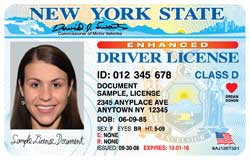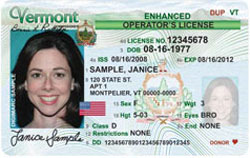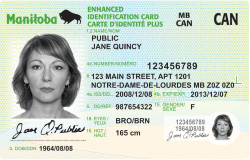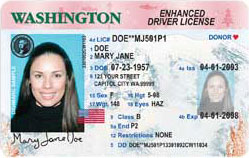“May We See Your Papers?” Redux: Enhanced Driver’s Licenses
Surely any of us who’ve had our DMV photograph compare unfavorably to Nick Nolte’s  mug shot would find the idea of enhancing a license to be appealing. However, this isn’t a makeover; it’s actually another travel document alternative to a traditional passport.
mug shot would find the idea of enhancing a license to be appealing. However, this isn’t a makeover; it’s actually another travel document alternative to a traditional passport.
Last week, I referenced the Western Hemisphere Travel Initiative, which requires travelers entering the United States from Canada, Mexico, the Caribbean and Bermuda to present either a passport or alternative document that proves identity and citizenship. Until recently, a birth certificate and photo ID had sufficed. By standardizing what documents can be used for entry (including returning home), and standardizing which supporting paperwork can be used to acquire those documents, the Department of Homeland Security’s U.S. Customs and Border Patrol believes it can better ensure safety.
But what does it mean for us? As travelers, we want to comply with regulations while neither having our wallets weighed down with redundant documents nor lightened in terms of available funds.

In effect, an enhanced driver’s license combines the properties of a regular driver’s license with those of a passport card. An EDL proves you’ve earned the right of driving privileges while also serving as proof of U.S. citizenship (if issued by a U.S. state) or Canadian citizenship (if issued by a Canadian province). Thus, you can use an enhanced driver’s license to cross the U.S.-Canadian and U.S.-Mexican borders by land or sea. As with the passport card, you can’t use an EDL as proof of identity for travel by air. (The International Civil Aviation Organization requires a traditional passport book for air travel.)
The main advantage of an enhanced driver’s license, aside from keeping the clutter in your wallet from bulking up, is reduced cost. Whereas a first-time passport book costs $100, EDLs generally cost $15-45 over the cost of a regular license. (In Canada, it’s $30-40 extra, though Quebec does not charge any extra fee beyond the cost of a regular license.) Costs vary depending on whether the EDL is acquired as a first-time driver’s license, a renewal, or a non-driver identification card, and whether your prior license has expired. Some states’ EDLs are even less expensive than passport cards.
While the passport card and Trusted Traveler program cards are issued by the Federal government, enhanced driver’s licenses can only be issued by individual states or provinces. Right now, the use of EDLs is not widespread; only four U.S. states and four Canadian provinces issue them, although recently, Minnesota governor Tim Pawlenty signed a law allowing enhanced driver’s license use. Minnesotans will be able to register for the new $15 enhanced licenses on June 1, 2012. (Yes, red tape takes time.) A Texas law authorizing the Texas Department of Public Safety to issue EDLs was passed and approved by a ruling from the Texas Attorney General, but remains unsigned by the governor.
Who Can Get an EDL?
Enhanced driver’s licenses are only issued by individual states or provinces, and only United States citizens legally residing in the state of issuance and Canadian citizens legally residing in the province of issuance can obtain an EDL.

Click on a state or province for detailed information regarding the EDL registration process. The fees indicated are for the cost of the EDL only, unrelated to other license-related charges:
Vermont $25
New York $30
Michigan $45
Washington $15

Quebec (where it’s known as Driver’s License Plus) $0
Ontario $40
Manitoba $30
British Columbia $35
What Documents Will You Need To Apply?
For American citizens:
1) Proof of Social Security Number — Bring any one of the following: your Social Security card, a W-2 or 1099, or a pay stub containing both your name and Social Security number.
In New York State, a first-time applicant will need to show an actual Social Security card.
In Michigan, a military ID with photo (DD2, DD1173, or CAC card) will also serve as proof of Social Security number.
2) Proof of U.S. Citizenship — Have your original or certified birth certificate (the kind with the raised, bumpy seal), OR an unexpired passport, OR a U.S. Certificate of Citizenship (Forms N-560 or N-561), OR a Certificate of Naturalization (Forms N-550 or N-570 or N578) OR a Consular Report of Birth Abroad issued by the U.S. Department of State (FS-240, DS-1350 or FS-545).
If the name on your certificate of birth, citizenship or naturalization doesn’t match the name on your Social Security card or other supporting documents, you’ll also have to bring proof of a legalized name change — for example, a marriage certificate, a divorce decree or a court order of name change.
3) Proof of Identity — You’ll need either a driver’s license (current or expired within the past three years), an out of state driver’s license, an unexpired passport or passport card, a federal, state or municipal government-issued photo ID card, or a valid military photo ID card.
In Michigan, a tribal photo ID from a federally recognized Native American tribe will also serve as proof of identity.
New York has a complicated system of points to prove identity, with different forms of documentation, from jury notices to pistol permits, each providing one to six points of proof toward the required total of six.
4) Proof of Residency — Each state has different requirements:
Vermont: Bring two pieces of mail addressed to you by name (Resident/Occupant won’t cut it) at your current street address. If you only use a post office box, you can alternatively show a utility or property tax bill showing your name and the street address, a lease or landlord statement, a Vermont EBT or AIM ID card, or a proof of a claim or coverage statement from your renter’s or homeowner’s insurance company.
New York: Show any two of the following:
–New York State license, learner’s permit, or a non-driver photo ID
–Original credit card statement on letterhead issued within the last 120 days
–Bank statement issued within the last 120 days
–Utility bill with name and address issued within the last 120 days
–Proof of current mortgage
–Federal or New York State Income Tax W-2 (with SSN) issued within the last year
–Current proof of homeowner’s/renter’s insurance policy or claim
–A New York State Professional License (medical, nursing, accounting, etc.)
–Federal or New York State Income Tax or Earning Statement (1099, 1098)
Michigan: Bring two of the following:
–Utility bill or credit card bill issued within the last 90 days*
–Account statement from a bank or financial institution issued within the last 90 days*
*Unlike in New York, where original letterhead is required, Michigan allows printouts of electronic copies for both of the above options.
–Michigan high school, college or university report cards or transcripts
–Mortgage, lease or rental agreement (Leases must include landlord’s phone number)
–Pay stub or earnings statement with the name and address of the employer
–Life, health, auto or home insurance policy
–Federal, state or local government documents (e.g., receipts, licenses or assessments) identifying the name and address)
–Michigan property or asset title or registration

Washington — Show any one of the following documents:
–Concealed weapons permit
–Homeowner’s insurance policy or invoice with address of the insured property or residence
–Home utility bill or hook-up work order dated within the past 60 days
–Mortgage documents
–Property tax bill or statement dated within the past 12 months
–Your name and address in a current phone book made by a telephone book publisher
–Moorage bill or contract showing that you live on a boat in a marina
–Federal or state government agency-issued check
–Tribal ID that contains your current resident address
–A filed property deed or title for your current residence
If you don’t have any of the above documents, the state of Washington will also allow you to provide two of the items from a lengthy list provided here, including a report card or transcript from an educational institution in Washington, making the process easier for older teens who still may live at home but not pay bills or even have jobs.
Canadian citizens will generally need a provincial birth certificate or Canadian citizenship document, a Canadian or U.S. driver’s license, and one other form of identification (though not proof of provincial residency), a well as, in some cases, a completed provincial questionnaire.
What’s So Enhanced About an Enhanced Driver’s License?
U.S. Customs and Border Protection worked work in tandem with individual states and provinces to develop a secure, tamper-resistant card that, like the passport and Trusted Traveler cards we discussed last week, have vicinity radio frequency identification (RFID) capability. The same RFID technology that lets you pay tolls electronically enables a machine to read data from a wireless “tag” without making any physical contact or even requiring a direct line of sight. (Vicinity just means that the machines that read the data can be up to 20-30 feet from the card.)
If it all works properly, travelers should be able to get into the right customs lane, point their card towards the RFID reader, and quickly advance with minimal fuss. The machines read the RFID chip, and wirelessly-accessed information from the chip signals the database. Then, biographical information, a photo, and the results of terrorist/criminal checks are displayed to the Customs and Border Patrol officer as your vehicle pulls up to the inspection booth. In theory, he or she can see the results quickly, focus on the people in the car, and assess the situation for (hopefully) faster processing.
Does an Enhanced Driver’s License Make Sense for You?
Obviously, unless you live in a state or province that currently allows for an EDL, the point is moot. If an enhanced driver’s license is available where you live, then the question is one of economics and convenience. Some things to ask (and remember, if you travel by air, you must use a passport book.):
Do you travel frequently enough to Canada, Mexico, the Caribbean or Bermuda (by land or sea) to make it worth paying the fee for an enhanced driver’s license?
If not, would a passport card suffice for occasional travel needs? (Or, do you already have a passport which you don’t find inconvenient to carry when traveling?)
If so, do you travel so frequently that it’s worth the upfront financial and time investment (including the interview process) to get a NEXUS or SENTRI card?
Bon voyage!




Follow Me